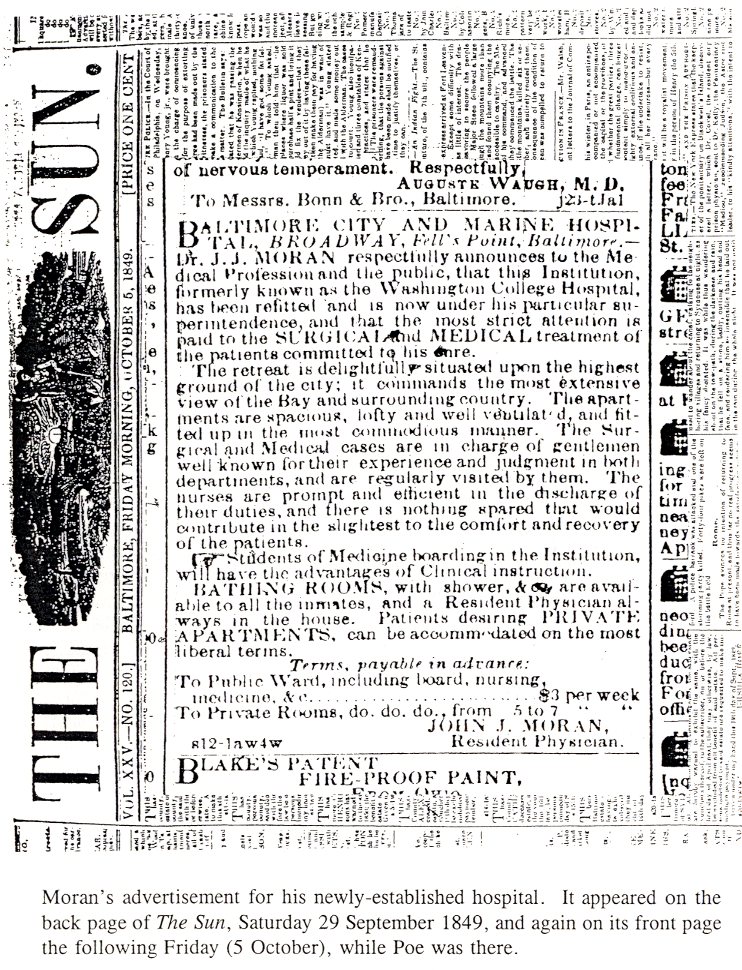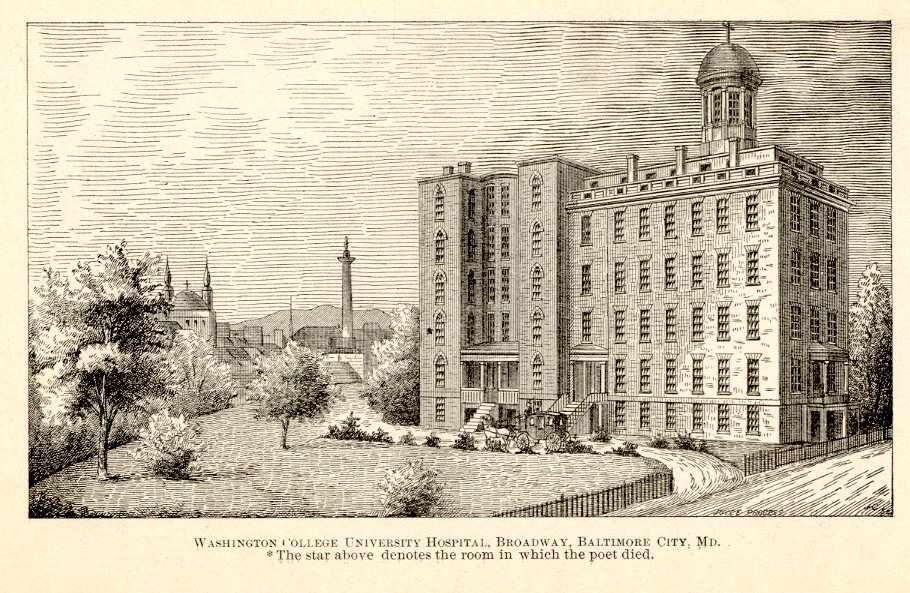
Too Much Moran: Respecting the Death of Edgar Poe

[THE TEXT OF THIS ADVERT CAN BE COPIED BY VIEWING SOURCE]
Too Much Moran: Respecting the Death of Edgar Poe by Michael A. Powell (2009; 180 pages, illus., with notes, bibliographic references, bibliography, maps, and index, $55.00; $60.00 [£40.00] international) ERRATA SHEET (PDF)
Poe set sail from Richmond, Virginia, at six o'clock Monday morning the 1st of October 1849 after having left his trunk and possessions in the care of his sister Rosalie at the MacKenzies' home in west Richmond and after having failed, and given up trying, to convince Mrs Shelton to marry him prior to departure.
He was admitted two days later into The Baltimore City & Marine Hospital, not the Washington Medical College Hospital, which no longer existed (see The Sun's notice above). There is no believable record, anywhere, of anyone working at the Hospital remembering Poe to have been known to be there. At the time of Poe's death (more correctly, at the time of the discovery of his body, early Sunday morning October 7th) the Hospital's administrator, Dr John J. Moran, was so ignorant of the identity of the man who had died under his roof that he did not even attend Poe's next-day funeral. With no one to contest his claims, the doctor compensated for his critical absence at the time of Poe's death by penning increasingly wild accounts of it over the next thirty-five years; this has formed both the myth by which Moran is remembered and the default Poe-death narrative for biographers.
Poe had been headed for New York, to return to Richmond with Maria Clemm and their gathered possessions. He intended a stop-over in Philadelphia for a quick and profitable editorial assignment. He did not pick up a letter waiting for him there. Though anecdotal, the highest probability is that Poe's rail journey was cut short by his becoming ill before reaching Philadelphia, resulting in his next-day return to the President street depot in Baltimore, six blocks north of which he was found sitting in an armchair of a public house. He had most likely been en route to the home and office of editor-friend Dr Joseph E. Snodgrass, another four blocks north. Sent word, and meeting him at the public house, Snodgrass had Poe cabbed to the nearby Hospital. There might only have been an hour or so between the arrival of Poe's train and discovery of him a short distance away. The possibility is demonstrated that Poe suffered from the effects of a rare neurotoxic disorder known as pathologic reaction to alcohol, a psychosis that pre-empts intoxication.
There is no mystery in this account. All known certainties are in accord with it. It is in virtually absolute disagreement with prevailing Poe biography. No missing five days. No "Reynolds!" No lying drunk in the gutter. No "cooping." No visit to N C Brooks. No thugs beating him up. Just a pitiful anonymous death in the public ward of a hospital whose name biographers have not cared to identify. Until now.

Moran's 1885 illustration showing both the wrong name for the hospital he operated and the wrong location for the place of Poe's death (the star-indicated turret room was, at that time, a dormitory for hold-over Washington Medical College students, as noted in the advert above; the public ward was the whole of the fifth floor on the right)
pacrimu.org / pacrimu.org.uk
press@pacrimu.org / press@pacrimu.org.uk
Pacific Rim University Press * Post Office Box 3031 * University Station * Eugene, Oregon * U.S.A. 97403-0031